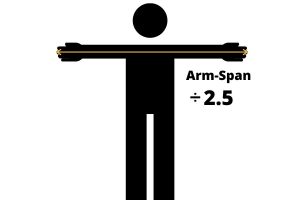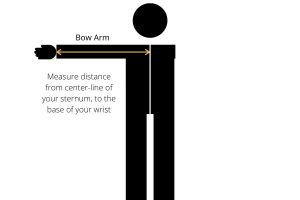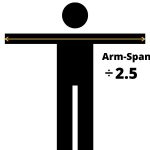how to measure your draw length
When attempting to fix a chemical compound bow, for best possible fitment, there are several steps, measurements, and calculations that must be accounted for. Of these diverse factors, few are as important as that of your bow's draw length. In order to ready this crucial adjustment, ane must commencement know how to measure draw length.
While the process of measuring your specific draw length is seldom hard, there are a number of key steps that must be adhered to.
What is Draw Length?
Describe length is nigh but described as the altitude betwixt a bow's riser and the most distant role of a bow'south string when at total draw.
This measurement is typically taken from the forwards-most part of a bow's grip to the betoken of pull on the bowstring.
The ATA (Archery Merchandise Association) specifies describe length in a somewhat broader sense when designating how chemical compound bows are to exist marketed.
According to the ATA, "Draw length is the altitude at the archer's full draw, from the nocking bespeak on the string to the pivot indicate of the bow grip plus 1 iii/4 inches."
The draw length of a item bow is of significance, due to the fact that it must be fix specifically to each private archer.
Every archer has their own correct draw length, which tin can differ substantially from that of the next individual.
This depict length is much like a shoe size, in the fact that such a measurement is unique from 1 individual to the adjacent, and must be compensated for in social club to achieve correct fitment.
Why is Draw Length Important?
The apply of the proper form is the single biggest cistron that influences an archer's accuracy.
One of the most significant factors pertaining to proper grade is the ability to anchor your shot consistently. This is where describe length plays an enormous role in overall accuracy.
If your bow'due south draw length is ready incorrectly, your ability to properly ballast your shot volition almost certainly exist negatively impacted.
As a result, your overall accurateness and consistency are likely to suffer. In short, y'all will never exist as accurate with a poorly set or misconfigured depict length adjustment, as y'all could be if everything was to be fix properly.
The reason that an incorrect draw length and anchor betoken negatively impacts accuracy is quite simple.
When at full draw, an archer's arms should be at a 90-degree angle to their body. Your trunk should essentially be configured to a "T" shape betwixt your torso and artillery.
When shooting a bow with an improperly adjusted depict length, this is nearly incommunicable to accomplish.
As a result, under-depict or overdraw scenarios can present themselves. Both of these scenarios are detrimental to the overall form and can lead to immense difficulty when attempting to group arrows with consistency.
Overdraw:
If a bow'southward draw length is set at as well great of a length for a particular archer, overdraw can be a business. When draw length is properly set, a bow will cam over into the valley, reach full draw, and stop at an archer'south approximate indicate of anchor.
When a draw length is set too long, the bow does not reach its back-cease before an archer's describe reaches a indicate where they can no longer ballast alongside the face up as needed.
This creates improper upper body geometry, which causes an archer's dorsum to bow and their chest to protrude. This can also lead to other issues outside of poor accuracy, such as forearm string slap.
Underdraw:
The polar opposite of overdraw is underdraw.
When a bow's draw length is too short for the archer who volition be firing it, an underdraw condition can be presented. When this occurs, the bow in question will cam over and reach its backstop far before actually reaching an archer's signal of ballast.
Instead of being able to proceed your body in a perfect "T" formation, your back will be hunched over and your shoulders drawn forward at the time of releasing an arrow.
Considering no true anchor point tin can be reached, accuracy typically nosedives when dealing with an underdraw scenario.
Measuring Draw Length
Much like any class of measurement, several schools of thought exist regarding how best to obtain your proper draw length value. Though these varying methods differ slightly in technique, they all still produce well-nigh identical figures when their steps are accurately followed.
The post-obit are some of the about popular ways of determining your correct depict length.
Wingspan Measurement

One of the well-nigh popular ways of determining depict length is with the use of wingspan measurements.
This method is quick, elementary, and efficient. All you need is an assistant, tape measure out, and a calculator.
To begin taking wingspan measurements, stand up with your dorsum every bit direct as possible, and extend your artillery outward to each side.
You will demand to ensure that your arms are level with i another, and parallel to the floor. When this tin can exist verified, information technology will exist time to have the necessary measurement.
Have an assistant advisedly measure out the distance from the furthest fingertip on one hand, to that on the opposite side. Brand certain that the measuring tape is pulled tight, and that no dangling complimentary-play exists. Have your assistant record the figure that they observed in inches.
You will at present divide the predetermined measurement past 2.5.
This will provide you lot with an authentic draw length effigy to which your bow should exist adjusted to accommodate.
Once any actual adjustments accept been made, it is always advisable to double-check the unit's fit and feel to ensure satisfactory results.
Sternum Midline Measurements (Push to Base Method)

Another viable way to determine an archer's correct draw length is by style of sternum midline measurements.
This method of measuring depict length is perhaps the simplest of all. However, the sternum midline method of measurement tends to be somewhat less accurate in nature and is intended to provide more of a ballpark figure than anything.
Using this method, y'all will stand up upright, with your bow arm (the arm which grips the bow) extended outward in a mode that places it parallel with the floor.
You volition then use a record measure to record the distance from the center-line of your sternum, to the base of your wrist on the arm that is extended.
The number in inches which is recorded will exist your personal draw length.
It might also be helpful to relax your arm for a elapsing of time, then remeasure one time more, in a bid to proceeds consistency.
Considering this method tends to be somewhat less precise than other methods of measurement, double-checking your figures again can add some level of uniformity to the process.
Measurement Arrows
All the same another mode of measuring draw length, is with the use of a specialized measuring arrow. These arrows can be constitute at most whatsoever archery pro-store and can be purchased via the internet as well.
These specialty arrows are marked with varying length designations along their shaft. These designations are and then used to have stock of an archer's draw length when readying for the shot.
Therefore, nothing more is needed when using this method of measurement, other than your bow, a measurement arrow, and an assistant.
To complete this procedure, simply nock a specialty measurement arrow onto the bow string of the bow you wish to set upwards.
Now have an banana watch as you slowly draw dorsum your bow until reaching a comfy anchor indicate.
Once anchored, your assistant volition notate the bow'southward measurement that is displayed on the pointer, at the exact location where information technology intersects the riser.
It is also important to recall that your course must be every bit it would when actually shooting while measuring your draw length in this manner. Doing so ensures that all measurements are correct and concise.
Depict Length Example Study
When measuring my describe length, I personally cull to utilize the to a higher place-mentioned wingspan measurement method.
I experience this method to be highly authentic and was taught this way of measuring draw length by an archery pro-shop owner in my surface area who has over thirty years of industry feel.
When setting up my latest compound bow, I stood in an upright manner, with my arms outstretched. In doing so, I fabricated sure that my arms were parallel with the floor at all times, as this avoids any discrepancies. I then had an assistant measure my wingspan from fingertip to fingertip.
This revealed a wingspan measurement of 70 inches. I and so divided this number by ii.5, which provided me with an overall depict length measurement of 28 inches.
This is a process that I have repeated several times throughout the years, as I make a habit out of double-checking such values of importance every fourth dimension I fix up a new bow that has been purchased.
Every time that I have measured my describe length in this manner, the results have been spot-on.
I merely set my new bow's draw length to that which I have figured, draw back, and anchor without any effect whatsoever (no matter if you are a right- or lefthanded archer).
In my stance, this has served as consistent proof that the wingspan method is a highly accurate ways of measuring draw length.
Bow Considerations For Describe Length
If you are new to archery, it is important to take your likely draw length into consideration when choosing a bow to buy (read.. Barebow my journey)
While the bulk of bows today feature describe length ranges that are suitable for most adults of average height, those that are shorter or taller in stature can find it to exist slightly more difficult to locate a bow that caters to their needs.
Since describe length is largely a product of height and wingspan, those that are under 5' in pinnacle, or over 6'4 in height, will likely find their draw lengths teetering on the outer extremes of what is offered by a number of standard compound bows on the market.
Those who are under 5' tall, are probable to have draw lengths of 23" or less, while those over half dozen'4 often have draw lengths that exceed 32".
This in no way excludes these individuals from locating an excellent bow that suits their needs. However, one must do their homework to ensure that they are not purchasing a bow that lacks the range of adaptability to accommodate them.
Luckily, at that place are a substantial number of highly adaptable bows available on today's marketplace, that most eliminate these sizing issues.
The Draw Length Equation
Although it might at first seem intimidating, the process of measuring your personal draw length is no more difficult than you make it. By employing whatsoever of the three methods described higher up, y'all tin can tape your draw length in a matter of only a few minutes.
The method that you choose to conduct this process is largely a matter of personal preference. However, it is important that you carefully follow the necessary steps to any process that is chosen.
This will ensure accurateness and spare y'all from being forced to make multiple fine-melody adjustments in a bid to recoup for any missteps or errors along the mode.
FAQ
What is Draw Length?
Draw length is most simply described equally the distance between a bow'southward riser and the most distant office of a bow's string when at full draw.
This measurement is typically taken from the forward-most part of a bow's grip to the point of pull on the bowstring.
Why is Draw Length Important?

The apply of the proper form is the single biggest factor that influences an archer's accuracy.
1 of the most pregnant factors pertaining to proper grade is the ability to anchor your shot consistently. This is where draw length plays an enormous role in overall accuracy.
Source: https://bowaddicted.com/how-to-measure-bow-draw-length/
Posted by: jacobsfooster.blogspot.com


0 Response to "how to measure your draw length"
Post a Comment